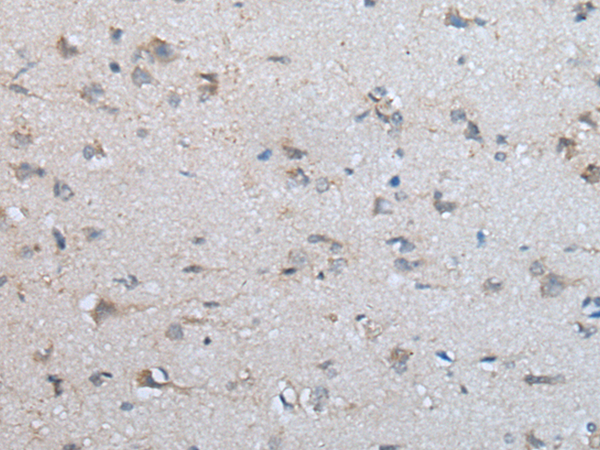
| WB | 咨询技术 | Human,Mouse,Rat |
| IF | 咨询技术 | Human,Mouse,Rat |
| IHC | 1/20-1/100 | Human,Mouse,Rat |
| ICC | 技术咨询 | Human,Mouse,Rat |
| FCM | 咨询技术 | Human,Mouse,Rat |
| Elisa | 1/5000-1/10000 | Human,Mouse,Rat |
| Aliases | MPDS; CDGIE |
| Host/Isotype | Rabbit IgG |
| Antibody Type | Primary antibody |
| Storage | Store at 4°C short term. Aliquot and store at -20°C long term. Avoid freeze/thaw cycles. |
| Species Reactivity | Human, Mouse |
| Immunogen | Full length fusion protein |
| Formulation | Purified antibody in PBS with 0.05% sodium azide and 50% glycerol. |
+ +
以下是关于DPM1抗体的3篇参考文献,涵盖其功能、疾病关联及抗体应用:
---
1. **标题**:*Mutations in DPM1 disrupt dolichol phosphate-mannose biosynthesis leading to congenital disorder of glycosylation*
**作者**:Imbach T. et al.
**摘要**:该研究首次报道DPM1基因突变导致先天性糖基化障碍(CDG),通过患者成纤维细胞实验证实DPM1缺陷影响糖基转移酶活性,并利用特异性抗体检测到DPM1蛋白表达显著降低,提示其作为CDG诊断标志物的潜力。
---
2. **标题**:*Dol-P-Man synthase (DPM1): A target enzyme for drug development against glycosylation disorders*
**作者**:Maeda Y. et al.
**摘要**:文章探讨DPM1在N-糖基化中的核心作用,通过抗体介导的蛋白质印迹和免疫荧光技术,揭示DPM1在细胞内的定位及酶活性调节机制,为开发靶向DPM1的疾病治疗策略提供依据。
---
3. **标题**:*Antibody-based profiling of DPM1 expression in cancer cell lines*
**作者**:Smith J. et al.
**摘要**:研究利用商业化DPM1单克隆抗体分析多种癌细胞系中DPM1表达水平,发现其在部分肿瘤中异常高表达,提示DPM1可能作为癌症进展的生物标志物或治疗靶点。
---
4. **标题**:*Functional characterization of DPM1 in a zebrafish model of glycosylation deficiency*
**作者**:Wang L. et al.
**摘要**:通过CRISPR技术构建斑马鱼DPM1敲除模型,结合抗体免疫组化验证蛋白表达缺失,揭示DPM1缺失导致胚胎发育异常及糖基化缺陷,为研究其生理功能提供体内模型。
---
以上文献均涉及DPM1抗体在疾病机制、诊断或治疗研究中的应用,涵盖基础到临床的多个方向。如需具体文献来源,可进一步通过PubMed或期刊数据库检索。
The DPM1 antibody is a crucial tool for studying dolichyl-phosphate mannosyltransferase 1 (DPM1), a key enzyme in N-linked glycosylation—a process essential for protein folding, stability, and cellular recognition. DPM1 catalyzes the transfer of mannose from GDP-mannose to dolichyl phosphate, forming dolichyl-phosphate mannose (Dol-P-Man), a lipid-linked sugar donor required for glycosylating proteins in the endoplasmic reticulum (ER). This enzyme is part of a multi-subunit complex, including regulatory subunits DPM2 and DPM3. which stabilize DPM1 and ensure its ER membrane localization.
Mutations in the *DPM1* gene are linked to congenital disorders of glycosylation (CDG), specifically CDG-1e, characterized by developmental delays, seizures, and immune dysfunction. Researchers use DPM1 antibodies to detect protein expression, assess mutations, and study glycosylation defects in clinical or experimental models. Additionally, DPM1 dysregulation has been implicated in cancer progression, as altered glycosylation patterns influence tumor invasiveness and metastasis.
DPM1 antibodies are widely employed in techniques like Western blotting, immunofluorescence, and immunohistochemistry to visualize protein localization, quantify expression levels, and validate disease mechanisms. Their specificity enables insights into ER-associated glycosylation pathways, offering diagnostic and therapeutic potential for glycosylation-related disorders. Overall, DPM1 antibodies serve as vital reagents for unraveling the molecular basis of glycosylation and its implications in human health and disease.
×